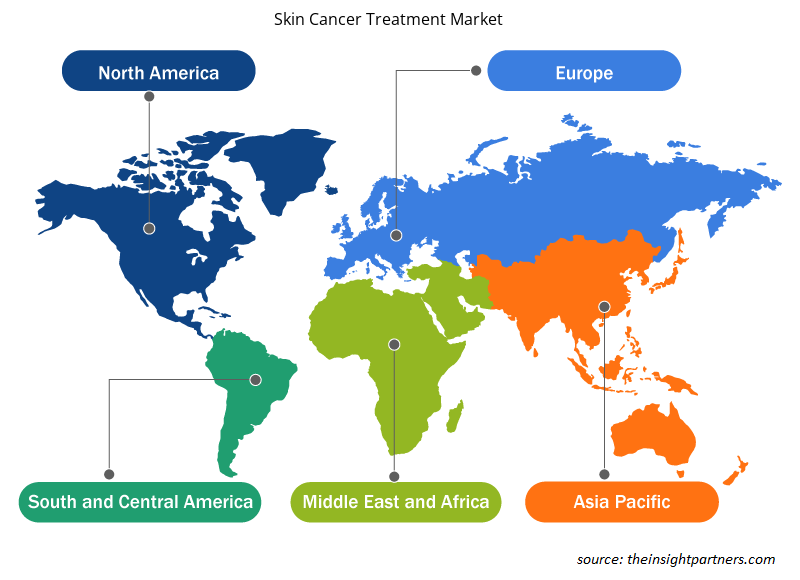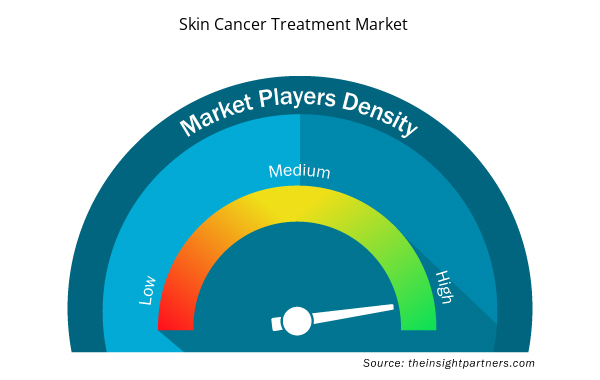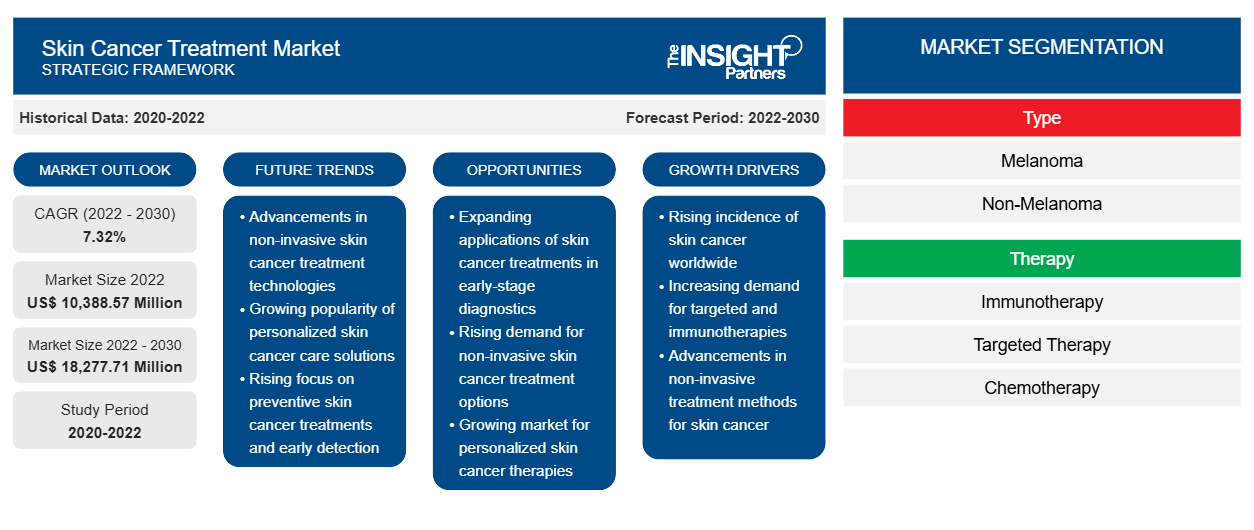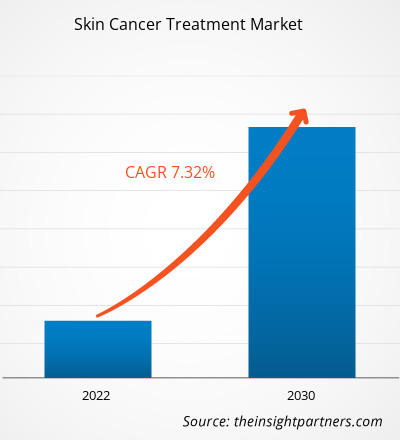[연구보고서] 피부암 치료 시장 규모는 2022년 10,388.57백만 달러에서 2030년 18,277.71백만 달러로 성장할 것으로 추산되며, 시장은 2022년에서 2030년까지 7.32%의 CAGR을 기록할 것으로 예상됩니다.
시장 통찰력 및 분석가 관점:
피부암 치료 시장 전망 은 이 시장의 이해 관계자가 성장 전략을 계획하는 데 도움이 될 수 있습니다. 흑색종과 비흑색종은 피부암 유형입니다. 과도한 햇빛 노출은 피부암을 일으킬 수 있습니다. 미국 피부과 학회에 따르면 피부암은 미국인 5명 중 1명에게 영향을 미칩니다. 또한 이 그룹에 따르면 약 300만 명의 미국인이 매년 비흑색종 피부암 진단을 받습니다. 흑색종과 비흑색종 피부암의 유병률이 증가함에 따라 시장 수익이 증가합니다.
면역 요법, 표적 요법, 화학 요법, 방사선 요법은 피부암에 사용 가능한 치료법 중 일부입니다. 또한 화학 요법의 한 형태로 분류되는 5-플루오로우라실 크림이 이 치료에 사용됩니다. 그러나 수술은 피부암에 더 효과적인 치료법이므로 선호되는 옵션입니다. 더욱이 피부암 치료 시장 동향에는 파이프라인 약물이 증가하는 것이 포함됩니다.
성장 동인 및 과제:
흑색종과 비흑색종의 유병률 증가는 피부암 치료 시장 규모를 촉진합니다. 흑색종과 비흑색종의 유병률 증가는 시장의 성장과 다각화를 촉진하는 중요한 원동력으로 부상했습니다. 피부암 치료에 사용되는 약물의 수는 질병의 유병률 증가와 대중의 인식 증가로 인해 최근 증가했습니다. 2022년에 발표된 미국 국립의학도서관의 최신 데이터에 따르면 미국에서는 매년 편평세포암(SCC) 180만 건과 기저세포암(BCC) 360만 건이 발생합니다. 피부암 발병률이 증가함에 따라 피부암 치료에 대한 수요가 촉진됩니다.
최근 몇 년 동안 지구 온난화의 가속화로 인해 사람들의 자외선 노출이 증가했습니다. 오존층 파괴가 더 심각한 지역 주민들 사이에서 피부암 사례가 증가했습니다. 호주 암 협회는 태양 노출로 인한 피부암이 매년 전국에서 보고되는 모든 암 사례의 80% 이상을 차지한다고 보고합니다. 이 그룹은 미국, 영국, 캐나다가 피부암 발생률이 가장 높다고 덧붙였습니다. 또한 노인 인구는 특히 피부암에 취약합니다. 이 지역의 노인 인구 증가가 시장 확대를 뒷받침할 것으로 예측됩니다.
피부암 치료 시장은 시장 성장에 영향을 미치는 기존 치료 방식의 부작용으로 인해 상당한 어려움에 직면해 있습니다. 수술, 화학 요법, 방사선 요법 , 면역 요법과 같은 기존 치료 옵션은 피부 자극, 전신 독성, 장기 합병증 등을 포함한 부작용을 초래할 수 있습니다. 부작용은 환자의 삶의 질에 상당한 영향을 미칠 수 있으며 일부 개인이 치료를 받거나 이를 고수하지 못하게 할 수 있습니다. 게다가 현재 치료 옵션의 한계로 인해 피부암에 대한 대체적이고 덜 침습적이며 보다 표적화된 치료법을 모색해야 할 필요성이 생길 수 있습니다. 연구 개발 활동이 개선된 안전 프로필과 효능을 갖춘 치료 방식을 발전시키는 데 집중함에 따라 시장은 이러한 과제를 해결하는 혁신적인 혁신을 목격하고 환자에게 새로운 희망을 제공하며 시장 확장을 촉진할 준비가 되어 있습니다.immunotherapy can lead to adverse effects, including skin irritation, systemic toxicities, long-term complications, and others. The side effects can significantly impact patients' quality of life and may deter some individuals from seeking or adhering to treatment. Moreover, the limitations of current treatment options may drive the need for the exploration of alternative, less invasive, and more targeted therapies for skin cancer. As research and development activities focus on advancing treatment modalities with improved safety profiles and efficacy, the market is poised to witness transformative innovations that address these challenges, offering new hope for patients and driving the expansion of the market. 따라서 기존 치료 방식의 부작용은 피부암 치료 시장 성장을 방해하고 있다.
귀하의 요구 사항에 맞게 이 보고서를 사용자 정의하세요
이 보고서의 일부 또는 국가 수준 분석, Excel 데이터 팩을 포함하여 모든 보고서에 대한 사용자 정의를 무료로 받을 수 있으며 신생 기업 및 대학을 위한 훌륭한 혜택과 할인 혜택을 이용할 수 있습니다.
- 이 보고서의 주요 시장 동향을 알아보세요.이 무료 샘플에는 시장 동향부터 추정 및 예측까지 다양한 데이터 분석이 포함됩니다.
보고서 세분화 및 범위:
“피부암 치료 시장 분석”은 다음을 고려하여 수행되었습니다.세그먼트: 유형, 치료법 및 최종 사용자를 기준으로 합니다. 유형을 기준으로 시장은 흑색종과 비흑색종으로 나뉩니다. 치료법에 따른 피부암 치료 시장은 면역 요법, 표적 요법, 화학 요법 , 방사선 요법 및 기타로 세분화됩니다. 최종 사용자에 따라 시장은 병원, 피부과 진료소, 진단 센터 및 기타로 세분화됩니다. 지리적 측면에서 피부암 치료 시장 보고서는 북미(미국, 캐나다 및 멕시코), 유럽(영국, 독일, 프랑스, 이탈리아, 스페인 및 기타 유럽), 아시아 태평양(중국, 일본, 인도, 호주, 한국 및 기타 아시아 태평양), 중동 및 아프리카(UAE, 사우디 아라비아, 남아프리카 및 기타 중동 및 아프리카), 남중부 아메리카(브라질, 아르헨티나 및 기타 남중부 아메리카)로 세분화됩니다.
세그먼트 분석:
피부암 치료 시장은 유형에 따라 흑색종 과 비흑색종으로 나뉩니다. 흑색종 세그먼트는 예측 기간 동안 더 큰 시장 점유율을 차지할 것으로 예상됩니다. 피부의 멜라닌 세포는 비정상적으로 분열되어 흑색종 피부암이라고 합니다. 여러 아시아 및 유럽 국가에서 흑색종 발병률이 증가함에 따라 이 세그먼트의 시장 성장이 촉진됩니다. 수술과 방사선 요법은 비흑색종 피부암의 주요 치료법입니다. 그럼에도 불구하고 흑색종 이외의 피부암을 치료하기 위한 면역 요법 약물의 출시는 향후 몇 년 동안 이 세그먼트의 시장 확대를 지원할 것으로 예상됩니다. 비흑색종 치료를 위한 치료 약물이 널리 사용 가능해짐에 따라 향후 몇 년 동안 시장이 성장할 것으로 예상됩니다.
치료법에 따라 피부암 치료 시장은 면역 요법, 표적 요법, 화학 요법, 방사선 요법 등으로 세분화됩니다. 방사선과 화학 요법의 부작용을 고려할 때, 면역 요법 약물은 피부암 치료에 더 자주 활용되고 있습니다. 더욱이 표적 요법과 같은 치료 옵션은 피부암 치료의 성공률을 높입니다. 피부암이 다른 치료 옵션이 실용적이지 않은 지점까지 진행되면, 의사들은 면역 요법과 표적 요법을 제안합니다. 이러한 요소들이 표적 요법과 면역 요법에 대한 피부암 치료 시장 성장을 촉진할 것으로 예상됩니다.향후 몇 년 동안 세그먼트가 확대될 것입니다. 더욱이 표적 치료 세그먼트는 2030년까지 상당한 피부암 치료 시장 점유율을 차지할 것으로 예상됩니다.
지역 분석:
피부암 치료 시장은 지역별로 북미, 유럽, 아시아 태평양, 중동 및 아프리카, 남미 및 중부 아메리카로 구분됩니다.
북미는 미국에서 피부암 발병률이 높고 암 치료제의 사용이 더 많기 때문에 피부암 치료 시장 성장에 가장 크게 기여하고 있습니다. 또한 주요 산업 참여자들이 피부암에 대한 새로운 치료법을 도입하려는 경향은 이 지역의 시장 확장에 유리한 영향을 미칠 것으로 예상됩니다. 비흑색종 피부암은 백인 인구에서 더 흔하기 때문에 북미와 유럽이 글로벌 시장의 상당 부분을 차지합니다.
아시아 태평양 지역의 피부암 치료 시장 규모는 호주와 뉴질랜드와 같은 국가에서 흑색종과 비흑색종의 유병률이 증가함에 따라 예측 기간 동안 가장 높은 비율로 성장할 것으로 예상됩니다. 아시아 태평양 지역에서 피부암 약물에 대한 규제 승인과 개발도상국의 규모가 크고 미개발된 시장이 결합되어 이 지역의 피부암 치료 시장 확대를 뒷받침합니다. 유럽에서 흑색종 사례가 증가함에 따라 예측 기간 동안 시장 수익이 건강하게 성장할 것으로 예상됩니다.
피부암 치료 시장 지역 통찰력
Insight Partners의 분석가들은 예측 기간 동안 피부암 치료 시장에 영향을 미치는 지역적 추세와 요인을 철저히 설명했습니다. 이 섹션에서는 북미, 유럽, 아시아 태평양, 중동 및 아프리카, 남미 및 중미의 피부암 치료 시장 세그먼트와 지리에 대해서도 설명합니다.

- 피부암 치료 시장에 대한 지역별 특정 데이터를 얻으세요
피부암 치료 시장 보고서 범위
| 보고서 속성 | 세부 |
|---|---|
| 2022년 시장 규모 | 10,388.57백만 달러 |
| 2030년까지 시장 규모 | 18,277.71백만 달러 |
| 글로벌 CAGR (2022-2030) | 7.32% |
| 역사적 데이터 | 2020-2022 |
| 예측 기간 | 2022-2030 |
| 다루는 세그먼트 | 유형별로
|
| 포함된 지역 및 국가 | 북아메리카
|
| 시장 선도 기업 및 주요 회사 프로필 |
|
피부암 치료 시장 참여자 밀도: 비즈니스 역학에 미치는 영향 이해
피부암 치료 시장은 소비자 선호도의 변화, 기술 발전, 제품의 이점에 대한 인식 증가와 같은 요인으로 인해 최종 사용자 수요가 증가함에 따라 빠르게 성장하고 있습니다. 수요가 증가함에 따라 기업은 제품을 확장하고, 소비자의 요구를 충족하기 위해 혁신하고, 새로운 트렌드를 활용하여 시장 성장을 더욱 촉진하고 있습니다.
시장 참여자 밀도는 특정 시장이나 산업 내에서 운영되는 회사나 기업의 분포를 말합니다. 주어진 시장 공간에 얼마나 많은 경쟁자(시장 참여자)가 존재하는지 그 규모나 총 시장 가치에 비해 나타냅니다.
피부암 치료 시장에서 활동하는 주요 회사는 다음과 같습니다.
- 일렉타
- 노바티스 AG
- F.호프만 라로슈 유한회사
- 데르마큐어-rt
- Xoft (iCAD, Inc.)
면책 조항 : 위에 나열된 회사는 어떤 특별한 순서에 따라 순위가 매겨지지 않았습니다.

- 피부암 치료 시장의 주요 주요 업체 개요를 알아보세요
산업 발전 및 미래 기회:
글로벌 피부암 치료 시장에서 활동하는 주요 업체가 취한 몇 가지 이니셔티브는 다음과 같습니다.
- 2023년 10월, 미국 FDA가 Opdivo(nivolumab)를 승인하면서 Bristol Myers Squibb는 이제 완전히 절제된 12세 이상의 성인 및 소아 환자를 보조 요법으로 치료할 수 있다고 발표했습니다. 이는 Opdivo의 현재 적응증을 확대하고 흑색종 환자에게 치료 옵션을 제공하는 회사의 유산을 더욱 발전시킵니다. Opdivo(n=526)와 위약(n=264)을 비교한 3상 CheckMate-76K 시험이 승인의 근거가 되었습니다.
- 2023년 3월, 프로그램된 사망 수용체-1(PD-1)을 표적으로 하는 인간화 단일클론 항체인 Zynyz가 전이성 또는 재발성 국소 진행성 메르켈 세포 암(MCC) 성인의 치료를 위해 미국 식품의약국(FDA)의 승인을 받았습니다. 종양 반응률과 반응 지속 기간(DOR)을 기준으로 FDA는 가속 승인 하에 Zynyz를 승인했지만, 이 적응증에 대한 Zynyz의 지속적인 승인은 확인 시험에서 검증 및 임상적 이점에 대한 설명이 필요할 수 있습니다.
경쟁 환경 및 주요 회사:
Merck & Co., Bristol Mayers Squibb, Novartis AG, Roche, Amgen Inc., GSK, Pfizer Inc., Sun Pharmaceutical, Regeneron Pharmaceuticals는 피부암 치료 시장 보고서에서 활동하는 몇몇 주요 회사입니다. 이러한 회사는 전 세계적으로 증가하는 소비자 수요를 충족하기 위해 제품 제공을 확대하는 데 중점을 두고 있습니다. 글로벌 입지를 통해 많은 고객에게 서비스를 제공하여 시장 점유율을 확대할 수 있습니다.
- 역사적 분석(2년), 기준 연도, CAGR을 포함한 예측(7년)
- PEST 및 SWOT 분석
- 시장 규모 가치/양 - 글로벌, 지역, 국가
- 산업 및 경쟁 환경
- Excel 데이터 세트



Report Coverage
Revenue forecast, Company Analysis, Industry landscape, Growth factors, and Trends

Segment Covered
This text is related
to segments covered.

Regional Scope
North America, Europe, Asia Pacific, Middle East & Africa, South & Central America

Country Scope
This text is related
to country scope.
자주 묻는 질문
The light therapy market was valued at US$ 10,388.57 million in 2022.
The light therapy market has major market players, including Merck & Co., Bristol Mayers Squibb, Novartis AG, Roche, Amgen Inc., GSK, Pfizer Inc., Sun Pharmaceutical, and Regeneron Pharmaceuticals.
Melanoma and non-melanoma are skin cancer types. Excessive sunlight exposure can cause skin cancer. As per the American Academy of Dermatology Association, skin cancer affects one in five Americans. Furthermore, according to the group, almost 3 million Americans receive a diagnosis of non-melanoma skin cancer annually. Growing prevalence of melanoma and non-melanoma skin cancer drives the market revenue.
Based on therapy, the skin cancer treatment market is segmented into immunotherapy, targeted therapy, chemotherapy, radiation therapy, and others. Considering the adverse effects of radiation and chemotherapy, immunotherapy medications are being utilized more often to treat skin cancer. Furthermore, treatment options, such as targeted therapy, improve skin cancer treatment success. When skin cancer has advanced to the point where other treatment options are not practical, physicians propose immunotherapy and targeted therapy. It is expected that these factors will boost the skin cancer treatment market growth for the targeted therapy and immunotherapy segments in the coming years.
The light therapy market is expected to be valued at US$ 18,277.71 million in 2030.
Based on type, the skin cancer treatment market is bifurcated into melanoma and non-melanoma. The melanoma segment is expected to hold a larger market share during the forecast period. Melanocytes on the skin divide abnormally, known as melanoma skin cancer. Rising incidence of melanoma in several Asian and European countries bolsters the market growth for the segment. Surgery and radiation therapy are main treatments for non-melanoma skin cancer. Nonetheless, the launch of immunotherapy medications to treat skin cancer other than melanoma is anticipated to support the market expansion for the segment in the next years. The market is expected to grow in the coming years as therapeutic medications for non-melanoma treatment become widely available..
The increasing prevalence of melanoma and non-melanoma has emerged as a significant driver propelling the growth and diversification of the skin cancer treatment market. The number of medications used to treat skin cancer has increased recently as a result of the growing prevalence of the disease and rising public awareness.
The List of Companies - Skin Cancer Treatment Market
- Elekta
- Novartis AG
- F.Hoffmann La-Roche Ltd.
- Dermacure-rt
- Xoft (iCAD, Inc.)
- Merck KGaA
- GalaxoSmithKline plc.
- Amgen, Inc.
- Eli Lily and Company
- Sun PharmaceuticalsMerck & Co.
The Insight Partners performs research in 4 major stages: Data Collection & Secondary Research, Primary Research, Data Analysis and Data Triangulation & Final Review.
- Data Collection and Secondary Research:
As a market research and consulting firm operating from a decade, we have published and advised several client across the globe. First step for any study will start with an assessment of currently available data and insights from existing reports. Further, historical and current market information is collected from Investor Presentations, Annual Reports, SEC Filings, etc., and other information related to company’s performance and market positioning are gathered from Paid Databases (Factiva, Hoovers, and Reuters) and various other publications available in public domain.
Several associations trade associates, technical forums, institutes, societies and organization are accessed to gain technical as well as market related insights through their publications such as research papers, blogs and press releases related to the studies are referred to get cues about the market. Further, white papers, journals, magazines, and other news articles published in last 3 years are scrutinized and analyzed to understand the current market trends.
- Primary Research:
The primarily interview analysis comprise of data obtained from industry participants interview and answers to survey questions gathered by in-house primary team.
For primary research, interviews are conducted with industry experts/CEOs/Marketing Managers/VPs/Subject Matter Experts from both demand and supply side to get a 360-degree view of the market. The primary team conducts several interviews based on the complexity of the markets to understand the various market trends and dynamics which makes research more credible and precise.
A typical research interview fulfils the following functions:
- Provides first-hand information on the market size, market trends, growth trends, competitive landscape, and outlook
- Validates and strengthens in-house secondary research findings
- Develops the analysis team’s expertise and market understanding
Primary research involves email interactions and telephone interviews for each market, category, segment, and sub-segment across geographies. The participants who typically take part in such a process include, but are not limited to:
- Industry participants: VPs, business development managers, market intelligence managers and national sales managers
- Outside experts: Valuation experts, research analysts and key opinion leaders specializing in the electronics and semiconductor industry.
Below is the breakup of our primary respondents by company, designation, and region:

Once we receive the confirmation from primary research sources or primary respondents, we finalize the base year market estimation and forecast the data as per the macroeconomic and microeconomic factors assessed during data collection.
- Data Analysis:
Once data is validated through both secondary as well as primary respondents, we finalize the market estimations by hypothesis formulation and factor analysis at regional and country level.
- Macro-Economic Factor Analysis:
We analyse macroeconomic indicators such the gross domestic product (GDP), increase in the demand for goods and services across industries, technological advancement, regional economic growth, governmental policies, the influence of COVID-19, PEST analysis, and other aspects. This analysis aids in setting benchmarks for various nations/regions and approximating market splits. Additionally, the general trend of the aforementioned components aid in determining the market's development possibilities.
- Country Level Data:
Various factors that are especially aligned to the country are taken into account to determine the market size for a certain area and country, including the presence of vendors, such as headquarters and offices, the country's GDP, demand patterns, and industry growth. To comprehend the market dynamics for the nation, a number of growth variables, inhibitors, application areas, and current market trends are researched. The aforementioned elements aid in determining the country's overall market's growth potential.
- Company Profile:
The “Table of Contents” is formulated by listing and analyzing more than 25 - 30 companies operating in the market ecosystem across geographies. However, we profile only 10 companies as a standard practice in our syndicate reports. These 10 companies comprise leading, emerging, and regional players. Nonetheless, our analysis is not restricted to the 10 listed companies, we also analyze other companies present in the market to develop a holistic view and understand the prevailing trends. The “Company Profiles” section in the report covers key facts, business description, products & services, financial information, SWOT analysis, and key developments. The financial information presented is extracted from the annual reports and official documents of the publicly listed companies. Upon collecting the information for the sections of respective companies, we verify them via various primary sources and then compile the data in respective company profiles. The company level information helps us in deriving the base number as well as in forecasting the market size.
- Developing Base Number:
Aggregation of sales statistics (2020-2022) and macro-economic factor, and other secondary and primary research insights are utilized to arrive at base number and related market shares for 2022. The data gaps are identified in this step and relevant market data is analyzed, collected from paid primary interviews or databases. On finalizing the base year market size, forecasts are developed on the basis of macro-economic, industry and market growth factors and company level analysis.
- Data Triangulation and Final Review:
The market findings and base year market size calculations are validated from supply as well as demand side. Demand side validations are based on macro-economic factor analysis and benchmarks for respective regions and countries. In case of supply side validations, revenues of major companies are estimated (in case not available) based on industry benchmark, approximate number of employees, product portfolio, and primary interviews revenues are gathered. Further revenue from target product/service segment is assessed to avoid overshooting of market statistics. In case of heavy deviations between supply and demand side values, all thes steps are repeated to achieve synchronization.
We follow an iterative model, wherein we share our research findings with Subject Matter Experts (SME’s) and Key Opinion Leaders (KOLs) until consensus view of the market is not formulated – this model negates any drastic deviation in the opinions of experts. Only validated and universally acceptable research findings are quoted in our reports.
We have important check points that we use to validate our research findings – which we call – data triangulation, where we validate the information, we generate from secondary sources with primary interviews and then we re-validate with our internal data bases and Subject matter experts. This comprehensive model enables us to deliver high quality, reliable data in shortest possible time.


 이 보고서에 대한 무료 샘플을 받으세요
이 보고서에 대한 무료 샘플을 받으세요